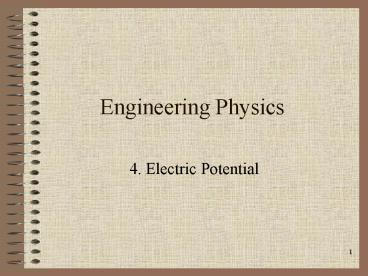Engineering Physics PowerPoint PPT Presentation
1 / 40
Title: Engineering Physics
1
Engineering Physics
- 4. Electric Potential
2
Main Topics
3
Definition of Work
4
Work done by Gravity
5
Energy
- Energy is the capacity to do work
- Potential energy energy by virtue of position
e.g. mgh joules - Kinetic energy energy by virtue of motion e.g.
½ mv2 joules - Energy can be converted from potential to kinetic
or visa versa
6
Troll Quiz
7
Converting PE to KE
8
EPE Electric Potential Energy
9
Convert EPE to KE
10
Electric Potential (voltage) I
11
Electric Potential (voltage) II
- We can now relate the work WAB done by the
electric field when a charge q0 moves from A to B
to the potential difference VB VA between the
points. - VB VA (EPEB/q0) - (EPEA/q0)
- - (WAB/q0)
- Or DV (DEPE/ q0) - (WAB/q0)
12
Electric Potential (voltage) III
13
Force v Potential
14
Correct SI Units
15
Worked Example
16
Definition of Electric Potential Difference
- The electric potential difference between two
points B and A is the work done (WAB) per unit
charge by an external force in taking a positive
charge from A to B - VB - VA WAB/Q (UB UA)/Q
- Or in integral form
17
Potential at a distance r from a Positive Charge Q
18
Calculate the Potential at A B
19
Where is the Potential Zero?
20
Scalar Field
21
The Electric Potential Energy of a Group of
Charges
- Equilateral triangle
- Top charge put in place first
- Left hand charge now added
- Finally, right hand charge is put in place
- Calculate the EPE of the system
- Does the order of placing the charges at the
three corners matter? - Could you calculate the potential at the centroid
of the triangle?
22
Troll Quiz
23
Equipotential Surfaces
24
Equipotential Lines I
25
Electric Field Lines
26
Equipotential Lines II
27
Potential Gradient
- The differential form of the equation opposite
is -
28
Important Points
- The net electric force does no work as a charge
moves on an equipotential surface. - The electric field created by any charge or group
of charges is everywhere perpendicular to the
associated equipotential surfaces and points in
the direction of decreasing potential.
29
Parallel Plate Capacitor
- Plate separation 3.2cm
- Plate PD is 64 V ( to -)
- Equipotential (light blue) surface PD is 3V (left
to right) - Hence, their separation is (3/64)x(0.032) m
- Note VB VA - 64 V
30
Troll Quiz
31
Capacitors
- For two parallel plates, each holding a charge of
magnitude Q, it is found experimentally that - - Q CV
- V is the voltage between the plates.
- C is a constant, and is called the capacitance of
the device. - C is measured in farads (F).
- A capacitor is a charge storage device.
32
Dielectrics I
- When a dielectric (insulating material) is placed
between plates the electric field is reduced from
E0 to E. - The dielectric constant is given by
- k E0/E
33
Dielectrics II
- For a uniform field, from the definition of
voltage, we have - V Ed, where d is the plate spacing.
- If the electric field is reduced, then so is the
voltage. - If the capacitor is isolated, Q remains
unchanged, and Q CV, then C must increase to
balance the equation.
34
Some Dielectric Constants
35
Proving the Capacitor Formula
- A is area of one plate d the plate spacing. E
is the electric field V the voltage between the
plates. - From definition of voltage E Vd
- From Gauss Law E s/e0 Q/Ae0
- Hence, Q (e0A/d)V or Q CV
- Hence, C e0A/d farads
- When a dielectric is present, replace e0 by ke0
in the formula for C. That applies also to
Coulombs law.
36
Worked Example - CJ 6ed 19.5
37
Energy Storage in a Capacitor I
- The electric force (felt by a charge dq) between
plates is E(dq) newtons. - The work done in bringing this small charge from
the negative plate to the positive plate is
E(dq)d joules. - E increases as charge is added in small amounts,
dq, to the positive plate. E is a function of q,
the charge on the plate at any time.
38
Energy Storage in a Capacitor II
- V q/C Ed, d is the plate spacing V increases
as charge is added to the positive plate. - Hence, Ed q/C - substitute for Ed in (3.)
above and integrate for o to Q Q is the final
charge on the positive plate and V is the final
voltage between the plates. - Energy(work done in charging) is
- ½ (Q2/C) ½ CV2
39
Energy Density
- The volume of the capacitor is Ad m3.
- The energy per unit volume for a parallel plate
capacitor is as follows - Energy density ½ (ke0A/d)(Ed)2/Ad
- ½ ke0E2
- This expression holds for any electric field
strength, not just between the plates of a
capacitor.
40
Troll Quiz

